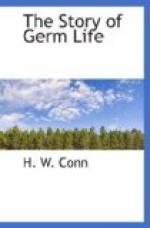This formation of peat appears to be a first step in the formation of denser coal. By a continuation of the same processes the mass becomes still more dense and solid. As we pass from the top to the bottom of such an accumulation of peat, we find it becoming denser and denser, and at the bottom it is commonly of a hard consistence, brownish in colour, and with only slight traces of the original woody structure. Such material is called lignite. It contains a higher percentage of carbon than peat, but a lower percentage than coal, and is plainly a step in coal formation. But the process goes on, the hydrogen and oxygen loss continuing until there is finally produced true coal.
If this is the correct understanding of the formation of coal, we see that we have plainly a process in which bacterial life has had a large and important share. We are, of course, densely ignorant of the exact processes going on. We know nothing positively as to the kind of microorganisms which produce this slow, peculiar fermentation. As yet, the fermentation going on in the formation of the peat has not been studied by the bacteriologists, and we do not know from direct experiment that it is a matter of bacterial action. It has been commonly regarded as simply a slow chemical change, but its general similarity to other fermentative processes is so great that we can have little hesitation in attributing it to micro-organisms, and doubtless to some forms of plants allied to bacteria. There is no reason for doubting that bacteria existed in the geological ages with essentially the same powers as they now possess, and to some forms of bacteria which grow in the absence of oxygen can we probably attribute the




